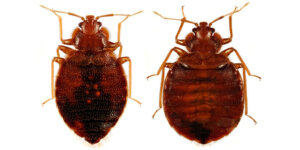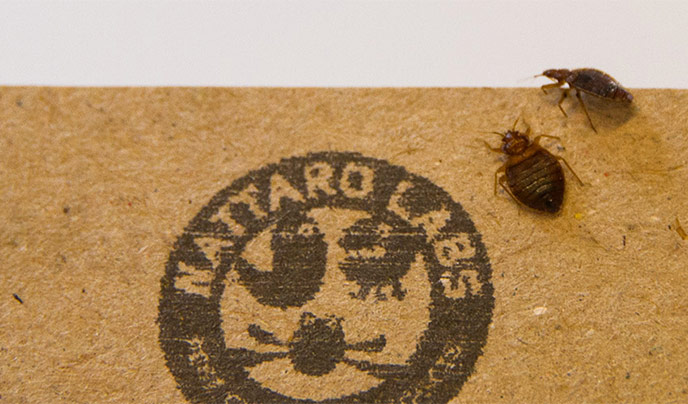CHINCHES DE CAMA - UN PROBLEMA CRECIENTE A NIVEL MUNDIAL
El problema de las chinches de cama está aumentando en el mundo por múltiples razones. Se cree que un factor importante es la adaptabilidad de las chinches de cama para sobrevivir cerca de nosotros y desarrollar resistencia a diferentes tipos de insecticidas.
Otras razones incluyen el aumento de los viajes, la globalización, la falta de protocolos, la detección tardía y el tratamiento deficiente. A medida que más y más hogares privados y establecimientos de hospitalidad tienen problemas con las chinches de cama, aumenta el riesgo de que el problema se propague en nuestros espacios públicos, como hogares de ancianos, hospitales y transportes.

Cimex Lectularius, macho y hembra
La historia de las chinches de cama
Las chinches de cama son plagas que se alimentan de sangre humana y salen por la noche a comer. Según las investigaciones actuales, no pueden causar enfermedades a través de sus picaduras, pero tener una infestación de chinches de cama puede ser costoso de muchas maneras, sin mencionar el impacto mental en los afectados.
Las chinches de cama se propagan principalmente a través de nuestras pertenencias. Son buenas para autoestopistas y, en la práctica, pueden viajar con nosotros a cualquier lugar. Las chinches de cama se recogen en los hoteles, pero también llevar muebles de segunda mano a su hogar puede ser un riesgo. Después de que se ha establecido una infestación y a medida que las chinches se multiplican, también aumenta el riesgo de que se propaguen a habitaciones o apartamentos adyacentes.
Siempre recomendamos que cualquier persona afectada por chinches de cama contrate a una empresa profesional de control de plagas tan pronto como haya signos de una infestación. Haga clic aquí para ver todos nuestros distribuidores expertos en su área. Cuanto antes podamos detectar, o mejor aún, prevenir, una infestación, más rápido se puede realizar un tratamiento y menor es el riesgo de que el problema se propague.
Preguntas Frecuentes sobre las Chinches de Cama
Bed bugs are small, oval, reddish-brown insects that live off blood. They are mainly active at night and bite people while they are sleeping. As far as is known today, bed bugs cannot spread diseases. When bitten, some people do not have any reaction at all, while others get itchy rashes and blisters and, in rare cases, severe allergic reactions. The presence of bed bugs can also cause insomnia, anxiety and, in the long run, entomophobia (the phobia of insects). Sometimes worse than the infestation, is the psychological trauma that can linger.
Bed bugs have five nymph stages of development before they become an adult, and they need to suck blood at least once between each stage to develop. Bed bugs are strict bloodsuckers, as they can only survive on blood. After a feeding of blood, an adult bed bug can grow from the size of a flax seed to as big as an apple pip. The females usually lay between 2 to 3 eggs per day under good conditions. Nymphs in their primary stages have the most difficulty surviving without blood, whilst adult bed bugs can survive without food for longer than a year by going dormant. It is almost impossible to starve out a bed bug.
Bed bugs do not fly or jump, but they are fast crawlers. They can spread through an active and passive dispersal. They either crawl in the direction of our odour and body heat, or hitchhike with our belongings and travel with us anywhere. In practice, they can get into any of our things, for example luggage, shoes, watches and soft toys, but really the list is endless.
Bed bugs like living close to their food, human blood. That is why 9 out of 10 times they are found where we sleep. Bed bugs are considered to be nocturnal, so most of the time they hide in dark confined spaces, cracks and crevices and only come out to feed on us. This usually happens at night when it is dark, which makes it even harder to discover an ongoing infestation early.
A single fertilised female bed bug is all that's needed for an infestation to happen, along with a human in the room.
Most of the time bed bugs come out to feed on us at night, so that’s why it's not always easy to see them. Instead, a sign of bed bugs can present as bites on the skin or droplets of blood on the sheets. They always leave behind the casings they have shed or fecal droppings and, occasionally, blood spots. These signs can be found on the seams of mattresses, bed frames, headboards and wall outlets to name a few places.
If you travel frequently and sleep away from home often or if you host many overnight guests, you are at a higher risk of encountering bed bugs. Before you enter a hotel room, inspect it and never put your luggage on the bed or under it. You can put clothes in plastic bags when travelling and place a Nattaro Scout™ detection trap in the room if you want to be on the safe side. When you get home, check your belongings and wash them. If you travel a great deal, you can be proactive with preventive solutions like Nattaro Safe™ bed bug tape in your bed and skirting boards that would stop any infestation from spreading, and a Nattaro Scout™ detection trap near your bed. If you are affected by an infestation, a Bed Bug Protector mattress cover will encase the bed and protect it.
The businesses that run the highest risk of bed bug problems are those that offer overnight stays. These can be different types of short-term residencies such as student housing and hotels. The higher turnover of guests that a hotel, B&B or bed has, the greater the risk of that place being affected by an infestation of bed bugs – and the more reason to install Nattaro Safe™ bed bug tape in these beds for a long-term continuous treatment that prevents any spread. Other businesses affected are public places like libraries and transportation, where bed bugs can hang around in the fabric of seats and you could be unlucky to pick one up from sitting down on a bus or train.
The fact that bed bugs are more attracted to dirty and untidy rooms is a myth. Even clinically clean homes have places for bed bugs to hide without detection, for example under beds, behind wall mouldings, etc. Bed bugs can survive on their own for up to 18 months, before they need their next feeding.
To be certain that you are dealing with bed bugs, you can place a Nattaro Scout™ detection trap in the room and see if it catches your insect. If it does, you are dealing with a bed bug problem and should contact a pest control professional.
It is very seldomly possible to remove an infestation of bed bugs only by cleaning. Early detection and immediate control measures are crucial when it comes to a bed bug infestation, to reduce the risk of spreading, limit the amount of suffering and the cost of treatment.
Contact a professional pest control company immediately. Do not try to take on a bed bug infestation yourself, as it can increase the problem. Using insect repellents also risks making the situation much worse. Neither should you start removing furniture or other items from suspected rooms. Leave everything as it is until the pest control expert arrives and investigates the problem. If you can cope, keep sleeping in your bed during the entire treatment period, even if it feels difficult. A mattress protector and bed bug tape can help reduce the discomfort. If you start sleeping on the sofa in the living room, the bed bugs will follow you, which may result in the infestation spreading and taking longer to eliminate.
Choose a professional pest controller who has training on bed bugs. Let the pest controller choose the most effective method for stopping the infestation – the bed bug treatment needs to be adapted according to the situation. Successful control takes time and requires a combination of mechanical/physical treatment methods; mattress protectors, active detection traps, heat, freezing, and, above all, diatomaceous earth. Ask your pest controller if they use Nattaro Labs’ products when doing a treatment. You can attach Nattaro Safe ® bed bug tape to your bed for a long-term continuous treatment that prevents any epidemic spread.

Áreas problemáticas
Donde hay humanos, hay riesgo de chinches de cama. Así de simple.

Nuestras soluciones
A diferencia de los métodos tradicionales y pesticidas que se utilizan cuando una infestación de chinches de cama es un hecho, los productos de Nattaro Labs pueden utilizarse antes, durante y después de una infestación de chinches de cama.
